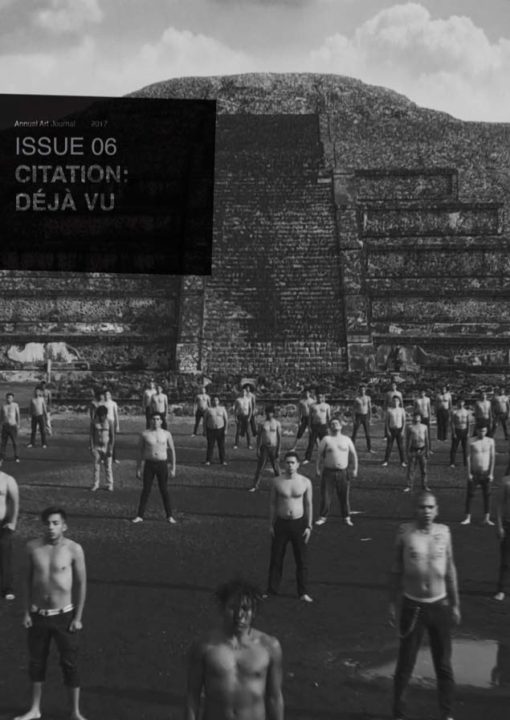By the end of the second decade of the 20th century, Piet Mondrian was already a formed landscape painter, slightly under the influence of Van Gogh, the Fauves and Pointillists. In 1911, at the Moderne Kunst Kring (Modern Art Circle) exhibition in Amsterdam, he became acquainted with the Cubist paintings of Picasso and Braque. For him, this was truly a watershed moment. Intrigued by new artistic tendencies, he moved to Paris that same year, joined the Cubists, socialised with them, and changed his painting style. In one of his reviews, Apollinaire soon noted Mondrian’s “very abstract Cubism.”1 Mondrian’s approach to Cubism is analytical – he radically dissolves a motif, insisting on the autonomous reality of image rather than the analysis of reality. Even at that time, Mondrian was systematic and gradually moved into the realm of abstraction. From the early 1912 to the summer of 1914, he got closer to the Purist understanding of line drawings – insisting on the inviolability of vertical and horizontal lines, and eliminating curved and even diagonal lines.
In 1914, because of his father’s illness, he was forced to leave Paris and return to the Netherlands. His father, a teacher and a religious fanatic, neglected the material aspect of existence, impoverishing the family because of his asceticism.2 Emerging from a rigid Protestant spirit, with an adopted Calvinist worldview, Mondrian’s Cubism of the time “was rational but not enough because it did not lead to the ultimate limit of reduction,” observed leading Italian art historian, Giulio Carlo Argan.3 Hence, Mondrian insisted on a drastic reduction: all was based on the rectangular positions of horizontal and vertical lines or regular square and rectangular planes, some of which he painted with primary red, blue and yellow. The solid, grid-like linear scheme became the conceptual basis of his paintings and his entire artistic philosophy. Mondrian’s contemporary, Herbert Read, identified the origin of this attitude. Forgoing all etiquette, he wrote: “Mondrian was not an intellectual in the conventional sense of the word and had no wide range of knowledge or experience. But he had mastered a vocabulary taken from a single source – the Dutch philosopher M.H.J. Schoenmaekers (Mathieu Hubertus Josephus Schoenmaekers).”4 Be as it may, Schoenmaekers appeared as an ideal interlocutor, because much of his philosophical discourse coincided with the Mondrian pictorial concept at the time. This refers, in particular, to the above-mentioned geometric linearism. In the book Principles of Plastic Mathematics (1916), Schoenmaekers wrote: “Nature is alive and unpredictable in its diversity, but basically it always works with absolute regularity, i.e. with plastic regularity,”5 whereas Mondrian, as pointed out by Herbert Read, “defines Neoplasticism as means by which the changeable nature can be reduced to the plastic expression of certain relations. Just like math, art becomes an intuitive means for presenting the basic characteristics of the cosmos.”6
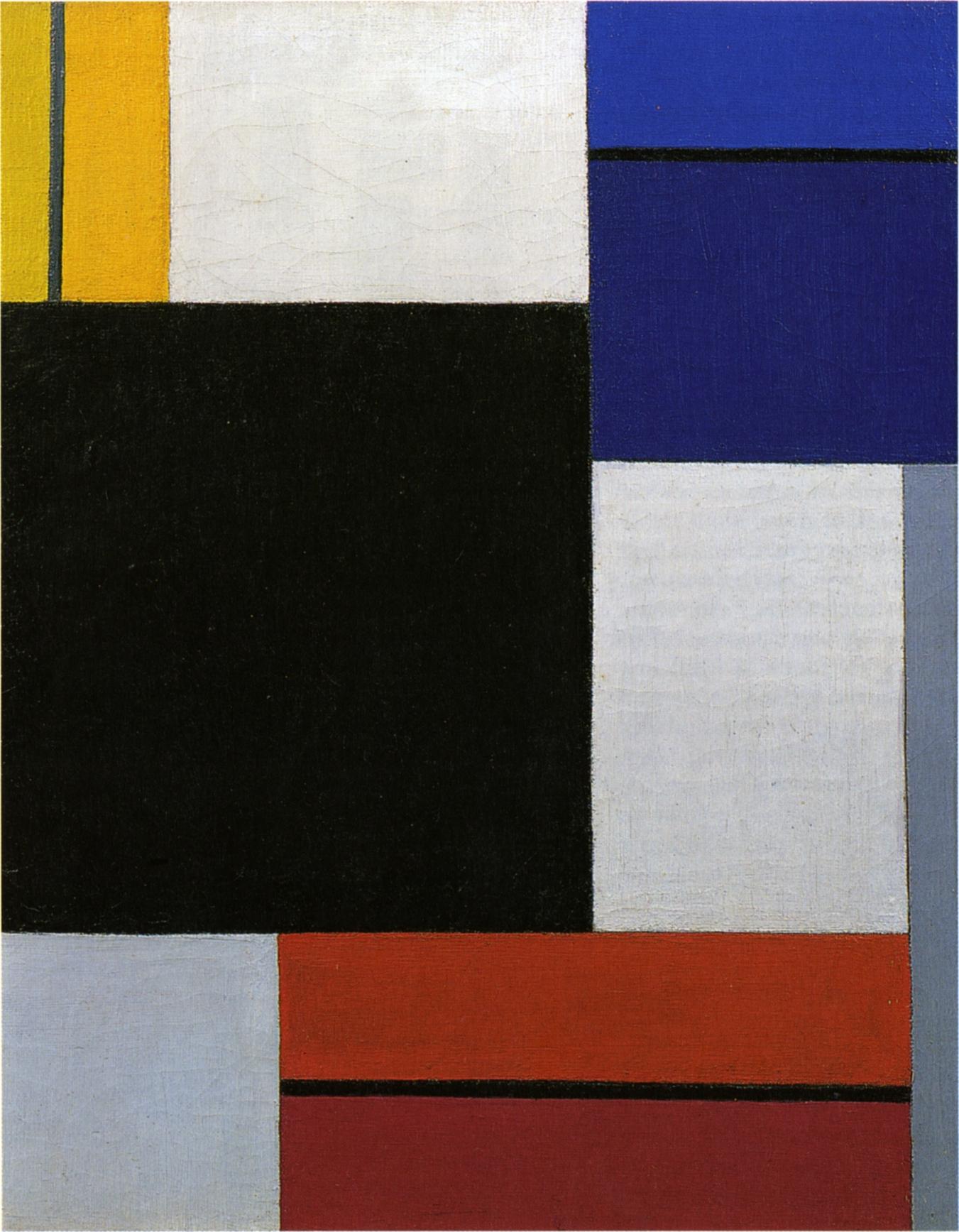
Theo van Doesburg, Composition XXI, 1923. Public domain.
Mondrian met Schoenmaekers in Laren, a small Dutch town about 30 kilometers east of Amsterdam, where he lived during the Great War. During the First World War, Laren was considered an artistic colony and was even called the “little Paris.” During his stay in Laren, Mondrian did not paint. Rather, he devoted himself to philosophical discussions with Schoenmaekers and wrote articles on the theory of painting. There, he also met Theo van Doesburg and Bart van der Leck, Dutch artists with similar ideas about the image. They were both painters of abstraction based on a rectangular geometry, primary colours, and balanced relations within the image. Thanks to Doesburg’s initiative, the three of them soon became the pillars ofDe Stijl group.7
Although Doesburg was the initiator and leader of De Stijl, the most important member of the group since its foundation was Piet Mondrian. He saw art as a possibility for realising the ideals of universal order and harmony, and it is on these principles that the whole group operated. Mondrian discussed this utopian obsession in the article, Neoplasticism in Painting, published in installments in the first 12 issues of De Stijl journal. The principal aspiration of Mondrian and other members of the group was to impose the principles of geometric painting and architecture onto society. However, one should bear in mind that these ideas were conceived in a specific social context. Mondrian’s Neoplasticism has a genuine civic origin. As Karl Ruhrberg shrewdly observes, both Mondrian’s oeuvre and the whole De Stijl concept are reflections of the Dutch landscape stolen from the sea by man. They symbolise the supremacy of the human spirit which brings order to unbridled, unregulated nature. “This does not mean that painters secretly reproduce nature. On the contrary, it means that neoplasticistic painting is the fruit of the very same spirit that creates order. Peace, harmony and discipline are characteristics of this art and its utopian goal is the complete harmony of the world.”8
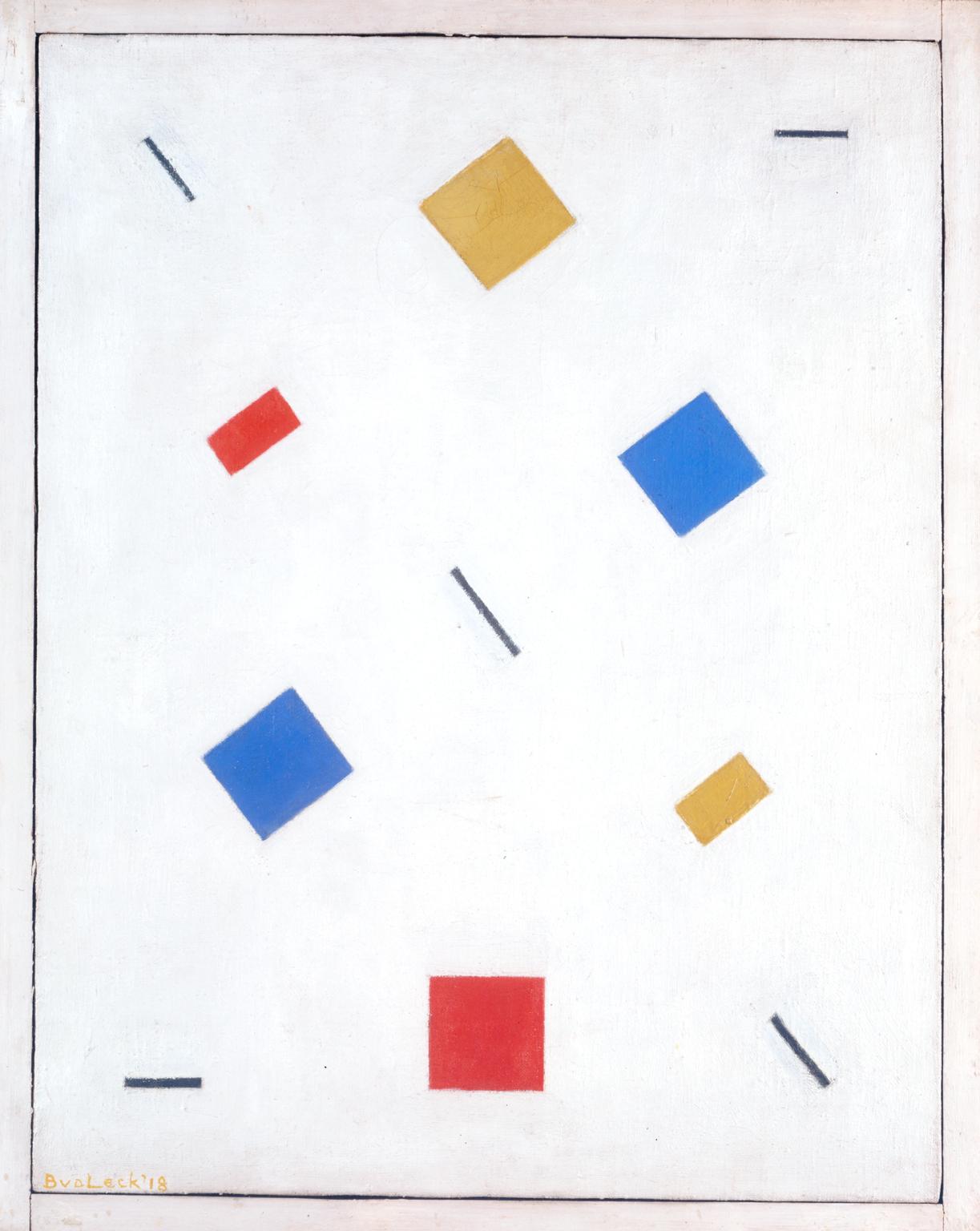
Bart van der Leck, Composition, 1918. Collection of Tate, DACS, 2017.
No matter how much this group of artists—gathered together in a small Dutch town of Laren in those dark war years—may have seemed “relocated” and isolated from the main trends of artistic modernity, today’s art history show that De Stijl made a major impact on the art and culture of the world. Argan notes that “De Stijl, in fact, is a key episode in understanding the history of contemporary art.”9 In the midst of rising political tensions, conflicts, the Great War, the Soviet revolution, the looming onset of Second World War, etcetera, the artistic idea of harmony was badly needed in the world. These were the circumstances and reasons that motivated not only Russian Constructivists and Malevich’s Suprematism, but also Mondrian’s geometric abstraction, De Stijl’s Neoplasticism, and the Bauhaus aesthetic. Amid the chaos of Europe during that time, artists were looking for different relationships, for harmony, for measure. The De Stijl’s Manifesto, written in 1918, states that the ongoing “war is destroying the old world with its contents and the new art brings a new awareness, a balance between universal and individual; and this new awareness is ready to be implemented in everything, even in outer life. Mondrian and the painters of Neoplasticism found this new awareness in their new organisation of image, especially in rationalist geometrism.” Argan aptly formulated Mondrian’s understanding of geometry in painting and art: “Ethica ordine geometrico demonstrata.”10
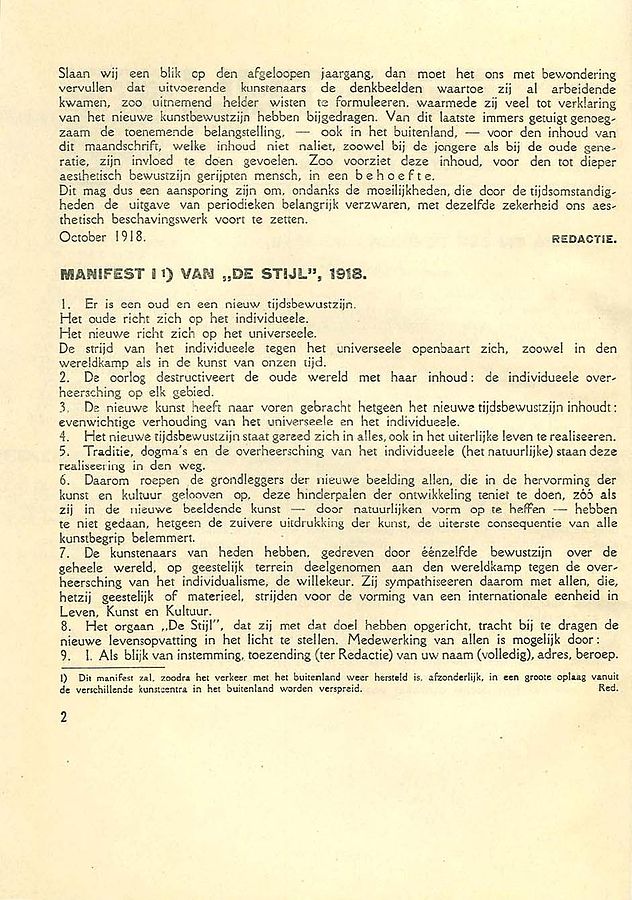
Manifest I of De Stijl, 1918. Public Domain.
Yet, art history tells us that Mondrian and his friends were not the only European painters of the time. The spirit of that time brought about changes. This will become especially evident once the closeness of Russian Constructivism, Malevich’s Suprematism, Mondrian’s rationalist abstraction, and De Stijl’s Neoplasticism is first observed and, perhaps, even more evident after their merger into the Bauhaus methodology. It was then, perhaps for the first time, that the ideal of the modernist awareness was realised. Filiberto Menna will later write about this in the book Project of Modern Art: “Aesthetic space therefore becomes a place for the movement of the individual in the direction of his full self-realisation: art activity, returned to the state typical of self-directed action, provides a model of behaviour and work upon which it is possible to establish a new relationship between subject and object, individual and collective. This is a romantic testament inherited by the artistic avant-garde movements of the 20th century and their aesthetic ideology: art is entitled to the autonomy of its own, not in order to be isolated but in order to offer its own model to other spheres of knowledge and practice.”11
Mondrian firmly believed in the same principles. For him, painting was increasingly becoming a social project for real life situations. After the end of the First World War, Mondrian returned to Paris and to his studio on Boulevard Raspail 278. It was there that he made his early cubist works, prior to 1914. His art, however, completely changed after the war. In line with new neoplasticist ideas, his work became plastically simpler, more socially effective, and more comprehensive. Mondrian completely rearranged his studio: he brought in minimalist furniture and painted the walls with black, red, blue, and yellow rectangles; he hung his characteristic geometric paintings on the walls; even his easel was precisely positioned as an object in a well-organised spatial composition. Mondrian’s studio space was arranged according to his pictorial scheme. The appearance of his artistic workshop was commented on by Carel Blotkamp: “His entire studio was arranged exactly as he imagined the world should look like – abstract and futuristic. His studio became a model of the environment he considered ideal: the walls were white, the whole space was very bright. The furniture was arranged in such a way that, when one looks at it, one gets the impression that it is a flat surface made up of geometric forms. His sofa, for example, looked like a black square from a distance. Even the easel, set against a wall, was an element of the interior, with its rectilinear form. Mondrian did not use it for painting; he painted at one of the tables. All this makes this whole thing exceptional, this absolute harmony of artistic expression and the space in which that expression becomes hypostatised.”12 Yet, no matter how harmonious the artist’s neoplasticist ideology, geometric paintings, and flawless studio environment may have seemed, Piet Mondrian’s life during his second Parisian period was very difficult. Neoplasticist works did not sell at all. In fact, it was only after 1921 that the classic Mondrian neoplasticist artworks were created. The first Mondrian painting was bought for a museum in Hanover in 1925. Between 1928 and 1932, he sold his paintings to several collectors from central Europe and America.
Mondrian’s art in the 1920s was adequate, necessary, and suggestive. Unfortunately, Adolf Hitler, after coming to power, saw such art as threat. In 1933, the Bauhaus closed and, in 1937, the Degenerate Art Exhibition was organised in Munich. The painting that Mondrian sold to the museum in Hanover was displayed. During this time, many artists left Europe. In 1938, Mondrian left Paris and went to London, where he stayed till the Battle of Britain in 1940. During the bombing of London, a bomb hit the house where he lived. After that, he moved to New York and lived in a studio on East 89th Street. Again, with a lot of enthusiasm, he arranged his studio in the neoplasticist manner. He put eight large compositions on the walls (collage wall paintings composed of monochrome sheets and little pieces of paper) and all the furniture was completely adapted to the surroundings. This enabled Mondrian to carry out his utopian ideas again and, as he himself said, it was the best place in which he lived. During his brief stay in New York, Piet Mondrian substantially influenced the development of post-war American modernism. His paintings—inspired by New York and jazz music—were much more dynamic than his earlier works. The dynamics of his intensely coloured squares between yellow lines depict the busy lifestyle of the metropolis, and introduced New York as a new centre for art in the aftermath of the Second World War.
After Mondrian’s death in 1944, his studio was opened to the public for six weeks. People were able to enter this castle of Neoplasticism and feel the revolutionary artistic idea which changed the former perception of the image and its meaning.13 In an article written on the occasion of Mondrian’s death, American theorist and renown promoter of American modernism, Clement Greenberg, wrote: “His pictures […] are no longer windows in the wall but islands radiating clarity, harmony and grandeur. […] Space outside them is transformed by their presence.”14
Greenberg saw the essence of Mondrian’s art. Geometry and simplicity in these images go beyond their aesthetic peculiarity, allowing this simple system of lines and squares, painted in primary colours, to become a plan and project of reality. Mondrian’s artistic concept is, therefore, frequently associated with architecture. Michel Seuphor began one of his essays by stating: “Mondrian is generally considered a father of modern architecture. This belief is one-sided and, indeed, false. Mondrian never made even the smallest architectural drawing. Although in his writings he sometimes talks about architecture, he essentially remains a painter, and believes that easel painting should introduce new times and forge a different society, in which architecture will indeed have an important place…”15
Gerrit Rietveld, one of the architects from the circle of De Stijl, was the first to apply the principles of Mondrian’s Neoplasticism in architecture and design. In 1917, he designed a chair that was inspired by Mondrian’s paintings. The design was very simple: it was composed of two well-balanced flat plates (the seat and backrest) that were supported by the frame of joints and slats. The plate surfaces were painted red and blue, with yellow slats at the intersections. All this was “embedded” in the supporting structure. In 1924, Rietveld designed and built the house of Schröder in Utrecht, marking a radical break from traditional architecture. The facade of this coherent minimalist building is pure and simple: clean white walls and panels, with visible structural elements (such as poles, railings, and window frames). Here too, Rietveld discretely uses Mondrian colours (red, blue, and yellow). The interior is flexibly designed. A series of sliding wall partitions make it possible to change the look and size of individual rooms. As noted by Argan, the Rietveld’s design and architecture, in this case, was based on the idea of pure construction.16 These are, perhaps, the first practical applications of Neoplasticism. In any case, today, a century later, they represent a model of European rationalism in architecture. The house of Schröder was placed on the UNESCO World Heritage List in 2000.
Even today, the link between Mondrian’s concept and architecture is relevant. Numerous buildings are built in accordance with more or less pronounced neoplasticist principles. Architecture still needs Mondrian, De Stijl and Neoplasticism. At the 2016 Biennale of Architecture in Venice, the Japanese artist, Hiroshi Sugimoto, presented his architectural installation, Glass Tea House Mondrian.17 The installation was set in a pavilion that had an open courtyard landscape and a closed glass cube. Sugimoto’s glass cube is the result of an experiment in which the artist searched for ideal relations and measurements, and strived to reach Mondrian’s aesthetic principle. He says: “I like to think that this tea house was designed by Mondrian.” Sugimoto’s exhibition concept relied on the subtlety of Mondrian’s reduced aesthetics, the subtlety which this Japanese architect synchronised with the subtlety of traditional Japanese tea ceremonies, thus achieving an effective contact of two aestheticisms, two cultures, and two different sensibilities.
Earlier this year, in 2017, monumental Mondrian paintings appeared on the facade of the Hague City Hall—a simple architectural building, completed in 1995, with a large interior space and stark white walls. This intervention on the facade of the building was done in celebration of the 100th anniversary of De Stijl and designed by one of the most respected American and international architects, Richard Meier. Meier’s architecture was a logical choice since his practice is deeply-rooted in the tradition of Modernism, De Stijl, the Bauhaus and Neoplasticism. The architecture stemming from the work of Mondrian and De Stijl is very functional; it has outgrown the formalism in which it was conceived; suggesting, even in early Rietveld examples, a specific architectural typology – where the neoplasticist architectural space is converted into a space on a human scale. Two artists from Rotterdam, Madje Vollaers and Pascal Zwart, came up with the idea of bringing Mondrian’s work into the urban setting of the Hague. They entitled their project The City as a Canvas.
The urban and architectural intervention in the Hague confirms the superiority of Mondrian’s painting. 2017 marks a century of the creation of Mondrian’s first “hard” geometric paintings in Paris (Composition in Black and White, Composition in Blue, Composition With Color Planes were all painted in 1917). Throughout this centennial period, Mondrian’s work has remained an authoritative aesthetic form in the world of painting, but also a relevant guideline to society in its everyday practice. The principles of his art are based on geometric harmony and structure. At first alone, then as a member of De Stijl, but also with the “recommendation” of the Bauhaus, Mondrian defined his work as a possible model for reality. The consequences of this attitude and behavior proved effective because its principles are applied in daily practice (architecture, interior design, applied art, fashion, music, etcetera). Significant contributions were also made by artists who accepted and developed the ideas of geometric painting and Neoplasticism after Mondrian’s death. Most prominent among them are his close associates from De Stijl who continued the group’s activities after 1944 – Dutch artists Bart van der Leck (1876-1958), Hungarian artist Vilmos Huszár (1884-1960), Belgian artist Georges Vantongerloo (1886-1965), and another Dutch artist Caesar Domela (1900-1992) who joined the group later, in 1925, as its youngest member. French artist Jean Gorin (1899-1981), another admirer of Mondrian, cultivated the concept of geometry and Neoplasticism since 1926, making a few “excursions” into the field of architecture.
Mondrian’s influence on American art during the last three years of his life in New York (from October 1940 to the beginning of 1944) is extremely important. In his essay, American-Type Painting, Greenberg expresses his appreciation of Mondrian’s work as “the most revolutionary move in painting” and considers Mondrian of vital importance to modernist processes in American post-war painting.18 The most dedicated Mondrianist in American art was certainly Harry Holtzman (1912-1987). Even as a young painter, he was inspired by Mondrian’s pictorial concept. In 1933, at the age of 20, he travelled to Paris to meet his idol. In 1940, shortly after the outbreak of the Second World War, Holtzman was the one who organised Mondrian’s departure for New York, who found him an apartment and a studio, provided him with conditions for work, and became one of his closest associates. As a successor of Mondrian’s New York legacy, Holtzman deserves much credit for the promotion of Mondrian’s work in America.19 He was one of the artists who, in addition to adopting Mondrian’s concept, also saw to it that the concept was transformed into three-dimensional objects. For his part, Mondrian supported Holtzman, as illustrated by one of his letters where he enthusiastically praises the relationship between Holtzman’s canvases and space, noting that “in the present three-dimensional works of H.H. the picture […] moves from the wall into our surrounding space.”20 Holtzman was also supported by Burgoyne Diller (1906-1965) who, after a brief Cubist experience in the early 1930s, dedicated all his efforts to the neoplasticist painting of the Mondrian type, managing to introduce an impression of personality. Reputed art critic, Larson, observes that “Diller’s work serves as a vital link between American abstraction of the 1930s and Minimalism of the 1950s and 1960s, epitomised by […] Donald Judd, Ellsworth Kelly and Myron Stout.”21 Ilya Bolotowsky (1907-1981), an American painter of Russian origin, established himself as the admirer of De Stijl principles and Neoplasticism. He considered Mondrian his teacher. His entire opus was marked by a rationalist concept of the image. When she heard the news of his death in 1981, the New York Times critic, Grace Glueck, wrote: “Ilya Bolotowsky, 74, dies; a neoplasticist painter.”22 Bolotowsky’s retrospective exhibition, held at the Solomon R. Guggenheim Museum in 1974, confirmed him as the artist who, in 1936, was one of the founders of American abstraction. It is interesting to follow these (and other) American artists who developed their own geometric neoplasticist paintings. As for the functional distribution of the ideas of Neoplasticism and geometric abstraction, it turned out that, during the first half of the 20th century, the world really needed Mondrian’s model.
In the post-Mondrian period, after the instructive function of Neoplasticism lost importance because of the newly-established modernisms of the second half of the 20th century, the doctrine of Neoplasticism survived in a state of quiet and discreet functionality through various concepts of geometric abstraction. This preserved not only the autonomy of the medium, but also the aesthetic and ethical principles of the image established through the activities of Mondrian, De Stijl and the Bauhaus. The 1960s, marred by the Cold War, saw the emergence of the “New Tendencies” movement in Zagreb at a time when the starting position of the movement was, in a way, very similar to the initial situation of De Stijl and the Bauhaus. Actors of the “New Tendencies” were seeking the socialisation and democratisation of art because society needed a new art project and new support. One of the most prominent actors of the “New Tendencies” was the French artist François Morellet who, in the 1950s, in a letter to Victor Vasarely said that he had “discovered” Mondrian and his ability to rationalise the image.23 Morellet, just like Mondrian, Theo van Doesburg and other members of De Stijl, used geometry to overcome the problem of style and its identification with the artist’s sensibility and personality. This suited the spirit of the new tendencies in the inchoate computer and pre-technological age.
Artists often refer to Mondrian paintings in their works. In 1964, the American pop artist Roy Lichtenstein produced a series graphics glorifying Mondrian’s art model.
During the last decades of the 20th century, geopolitical changes in Eastern Europe caused numerous crises. Countries created after the war, amidst the disintegration of Yugoslavia, witnessed the re-emergence of Mondrian’s concept in contemporary art. Particularly in Serbia, the crisis has been unfolding for a long time: It started in the fatal 1990s. Burdened with destruction (political, economic, cultural, moral, etcetera) and the entropy of all values, the crisis turned into a long-term issue in 2000. Serbian artists confronted this social situation with rationalism, structure and harmony. This is also why they turned to Mondrian’s art. In 1992, at the beginning of the great crisis, three young Belgrade artists Aleksandar Dimitrijevic, Zoran Naskovski and Nikola Pilipović organised the exhibition “Project Mondrian, 1872-1992” to mark the 120th anniversary of the artist’s birth.24 They were ‘relying’ on Mondrian’s painting, Composition II, 1929, which has been displayed in the National Museum in Belgrade since 1931. At the exhibition, not one of them quoted Mondrian directly. Instead, by consistently implementing their own ideas of geometry—pure and extremely reduced understanding of the image and of painting—they tried to establish themselves through the principles of authentic aesthetic and ethical comment. As noted in the exhibition catalog by the Serbian art critic, Jesha Denegri: “The artists from this part of the world felt Mondrian to be close to them, and necessary, at the time which, together with everything else deadly and negative, brought into the field of art a surge of extreme localism and ideologically indoctrinated false patriotism. These artists tried to find a counter-response to this in the qualities and virtues of the spiritual, both sensitive and rational, even utopian (since “utopia”, Argan asserts, in the contemporary historical situation, still is the most concrete of all moral values), therefore, in all that is essential, as specifically embodied in Mondrian’s work.”25
The conclusion must be drawn that the paintings of Piet Mondrian are very much needed in the world and in art today. He is an artist who managed to turn painting into a project of social life. Argan notes: “He does not dream of a utopian society without contradictions, but a society which every day shows more ability to solve its own contradictions and does it in a reasonable and non-violent way […] Therefore, although his paintings look cold (or maybe because of it), Mondrian is, after Cézanne, arguably the greatest, brightest and most enlightened mind in the history of modern art.”25
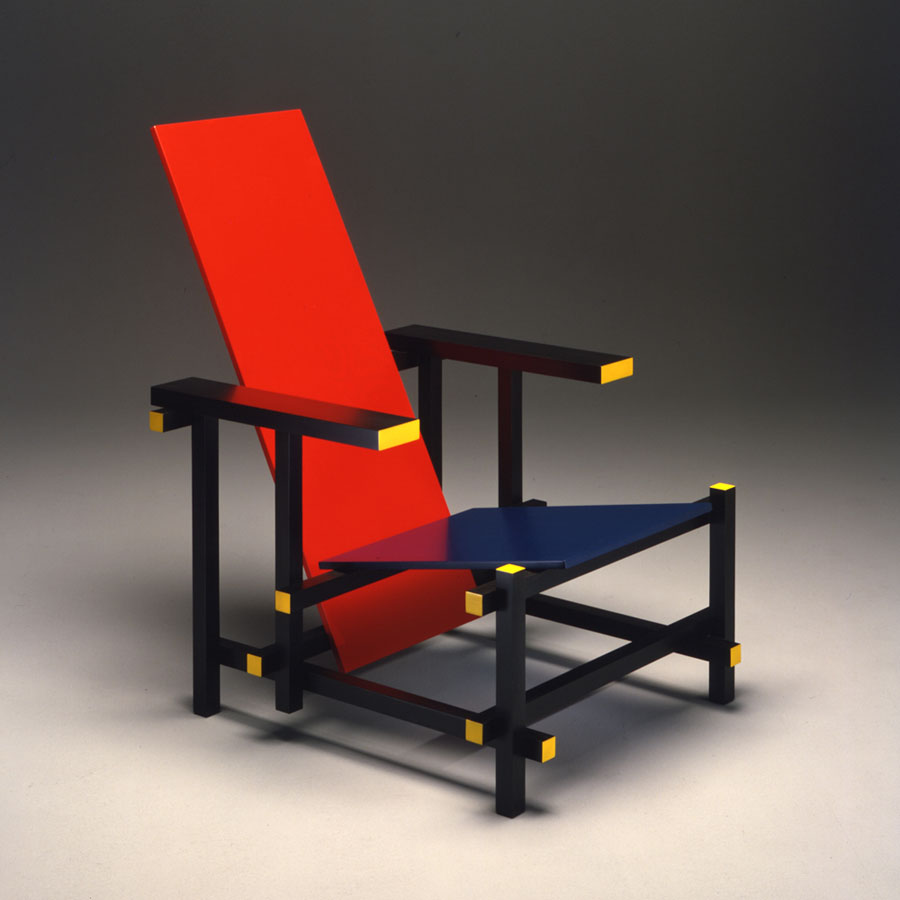
Tomas Gerrit Rietveld, Red and Blue chair, 1917. Public Domain.
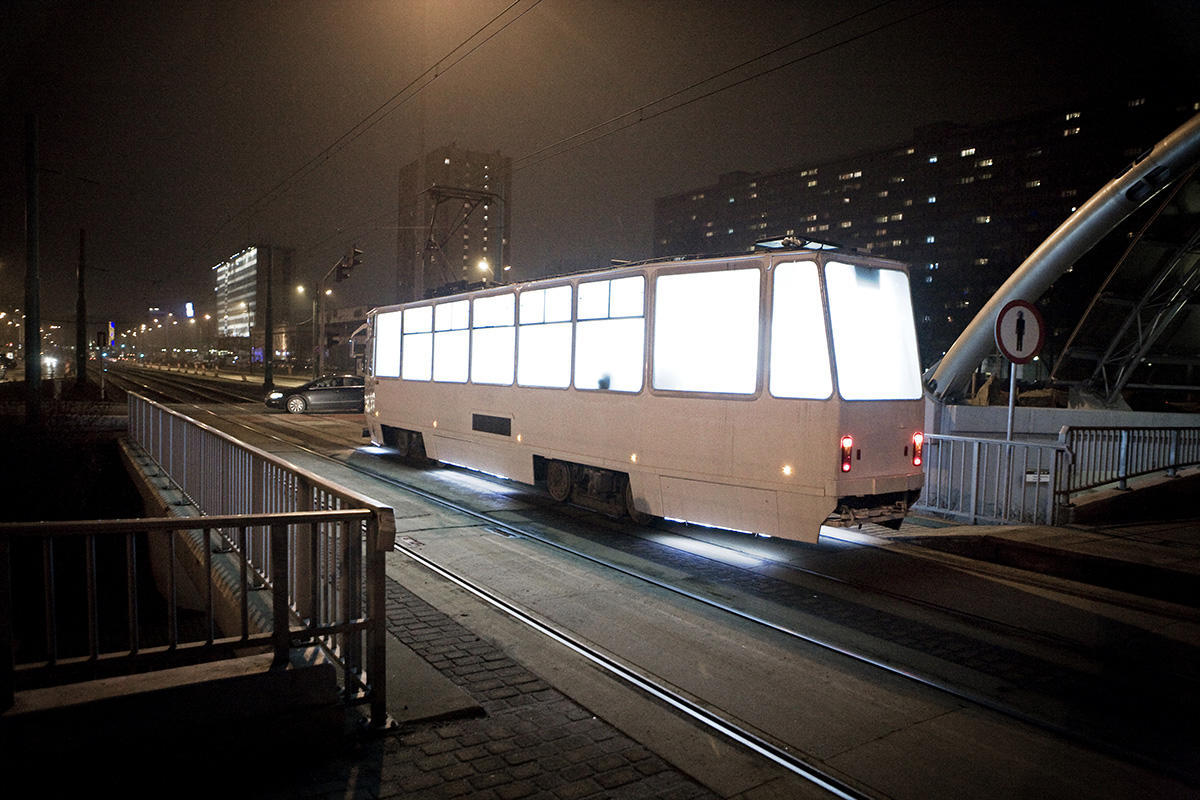
Mischa Kuball
public preposition / ghostTram
2013
Tram from Katowice and other Silesian cities operated after dark,
unpredictable route and travelling time, white foil, extra illuminants, light installation
Institution of Culture, Katowice / PL
Photo by Krzysztof Szewczyk, Katowice
© Archive Mischa Kuball, Düsseldorf / VG Bild-Kunst, Bonn 2017

